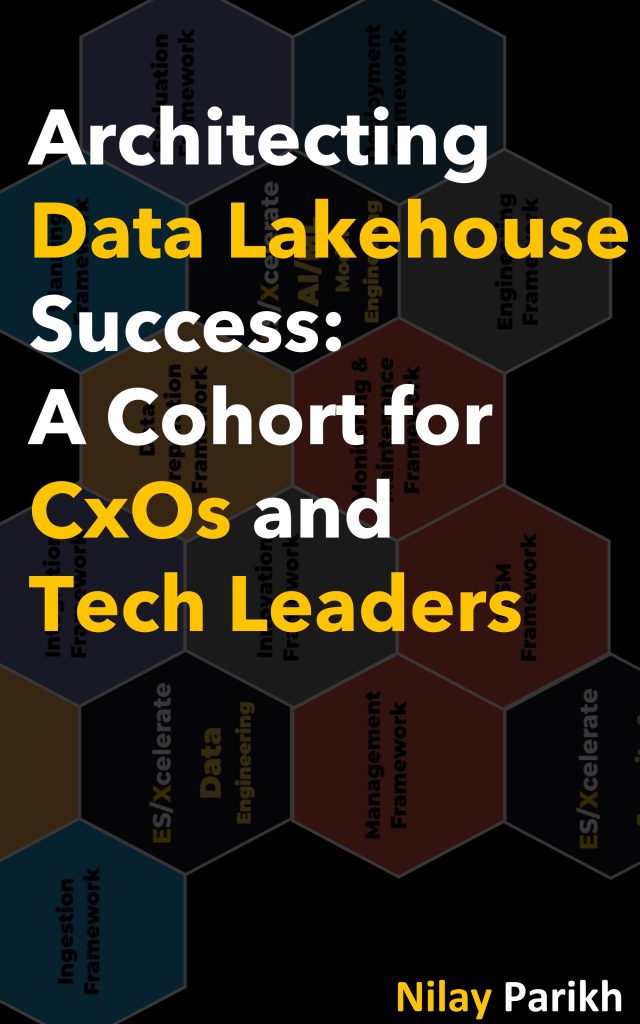
In “Architecting Data Lakehouse Success: A Cohort for CxOs and Tech Leaders,” we embark on an insightful journey through the evolving landscape of data engineering and architecture. This book is a comprehensive exploration, spanning the history, anatomy, and practical application of data lakehouses. It’s designed for technical leaders, architects, and C-suite executives who aim to merge strategic business vision with technical architectural prowess.
Chapter 5 of our book delves into the intricacies of storage architecture and data ingestion in the context of data lakehouses. It begins by outlining the critical attributes necessary for a scalable storage layer, emphasizing aspects like horizontal scalability, elasticity, and the ability to handle diverse workloads. The chapter then moves on to explore various storage formats such as Parquet, Delta Lake, and Avro, each serving distinct purposes like optimizing analytics, transactions, and serialization, respectively. Furthermore, it contrasts the different data ingestion patterns, including real-time and batch processes, and highlights the importance of streaming architectures with tools like Kafka and Flink. This comprehensive analysis provides valuable insights into building a robust and scalable storage foundation that can adapt and grow with evolving data needs.
The chapter also presents an in-depth examination of the characteristics essential for a scalable storage layer, vital for constructing a high-performance and flexible data lakehouse. It discusses the limitless scalability achievable through cloud-native services like Amazon S3 and Azure Blob Storage, alongside strategies for cost optimization, high throughput, low latency, and data resiliency. Security and interoperability are also underscored as critical components of a modern storage architecture. Moreover, the chapter offers a thorough evaluation of real-time versus batch data ingestion patterns, explaining their respective advantages, such as low latency analytics and operational efficiency. This nuanced understanding guides architects and leaders in making informed decisions that align with organizational data requirements, thus enabling the creation of efficient, effective data pipelines for business success.
Architectural Principles for Solution & Technical Architects and Enterprise Architects
| Principle | Description | Exceptions |
|---|---|---|
| Modular Design | Applications should be designed in a modular fashion to support scalability and adaptability to changing data and storage needs. | May not apply to legacy systems that are not feasible to refactor. |
| Interoperability | Ensure application compatibility with a range of data formats and ingestion patterns. | Specific applications with a narrow, defined scope may not require extensive interoperability. |
| Format Flexibility | Choose data storage formats based on specific use cases, like Parquet for analytics and Delta Lake for transactional data. | In cases where a single data format is dominant, flexibility may be less critical. |
| Scalable Ingestion | Data ingestion methods should be scalable, choosing between real-time or batch processing based on data characteristics. | Small-scale systems with predictable data inputs may not require scalable ingestion methods. |
| Elastic Resource Management | Operational resources should scale horizontally based on demand, leveraging cloud-native services. | Fixed capacity resources might be used where demand is predictable and stable. |
| Comprehensive Data Security | Implement robust security measures like encryption, access controls, and data masking to protect data integrity and privacy. | Some data might not require stringent security measures, such as publicly available information. |
| High Availability | Design infrastructure with redundancy and failover mechanisms to ensure continuous availability. | Non-critical systems may not require high availability setups. |
| Data Lifecycle Management | Implement policies for data retention, archiving, and deletion to optimize storage costs and compliance. | Short-term projects or transient data may not require extensive lifecycle management. |
| Real-Time Observability | Implement real-time monitoring for storage utilization, performance bottlenecks, and data flows for proactive management. | Systems with low complexity and user impact may not need real-time observability. |
This table provides a holistic view of the principles that should guide architects across various domains, while also acknowledging the exceptions that may arise due to specific circumstances or constraints.
Risk Areas and Mitigation Strategies
| Risk | Mitigation |
|---|---|
| Scalability Limitations | Plan for horizontal scalability using cloud-native services; employ auto-scaling capabilities. |
| Cost Overruns | Implement tiered storage, data lifecycle management, and resource allocation based on access patterns. |
| Data Ingestion Bottlenecks | Optimize data ingestion processes by choosing appropriate methods (real-time or batch) based on data needs. |
| Data Integrity Issues | Use formats like Delta Lake for ACID transactions and robust validation mechanisms. |
| Security Vulnerabilities | Implement robust security measures including encryption, access controls, and data masking. |
| Inadequate Disaster Recovery | Establish automated failover mechanisms and rapid disaster recovery plans. |
| Performance Inefficiencies | Utilize strategies like partitioning, indexing, caching, and parallelization to increase throughput. |
| Limited Interoperability | Ensure open formats and standardized APIs to facilitate interoperability across various engines. |
| Ineffective Monitoring | Deploy real-time monitoring tools for storage utilization, performance bottlenecks, and data flows. |
| Complexity in Data Processing | Simplify data processing architectures (like moving from Lambda to Kappa architecture where appropriate). |
| Inefficient Data Format Selection | Evaluate data formats (Parquet, Delta Lake, Avro) against use cases for optimal performance and efficiency. |
These risk areas and mitigation strategies, derived from the provided chapter context, are crucial for Solution & Technical Architects and Enterprise Architects to consider in order to ensure robust, secure, and efficient data management and storage solutions.
Six Thinking Hats
Using Edward de Bono’s Six Thinking Hats method, let’s list realistic scenarios for Solution & Technical Architects and Enterprise Architects based on the provided context of storage architecture and data ingestion:
White Hat (Factual Thinking)
- Scenario: Assessing the current data volumes and projected growth, and how the existing infrastructure (possibly involving traditional data warehouses) is handling it. This includes evaluating the performance of current storage formats (like Parquet, Delta Lake, Avro) and ingestion patterns (real-time, batch).
- Action: Gather data on current system performance, usage statistics, and future data projections to inform the need for scalable solutions.
Black Hat (Critical Thinking)
- Scenario: Considering the risks of scalability limitations, cost overruns, and data security vulnerabilities in the proposed scalable storage architecture.
- Action: Critically assess potential risks and develop contingency plans, including robust security measures and cost management strategies.
Green Hat (Creative Thinking)
- Scenario: Finding innovative ways to handle data ingestion and storage, such as exploring new cloud-native services or developing a unique combination of real-time and batch processing tailored to the organization’s needs.
- Action: Encourage brainstorming sessions to explore creative solutions and new technologies that can improve scalability and efficiency.
Blue Hat (Process Control Thinking)
- Scenario: Managing the overall process of evaluating, designing, and implementing a scalable storage architecture.
- Action: Oversee the process to ensure that it stays on track, all perspectives are considered, and decisions are made based on a balanced view of facts, risks, benefits, and creative options.
Six Thinking Hats, provide a structured way for architects to approach the challenges and opportunities in storage architecture and data ingestion, ensuring a comprehensive and balanced strategy.
Available at Amazon
- US: https://www.amazon.com/dp/B0CR71D58S
- UK: https://www.amazon.co.uk/dp/B0CR71D58S
- IN: https://www.amazon.in/dp/B0CR71D58S
- DE: https://www.amazon.de/dp/B0CR71D58S
- FR: https://www.amazon.fr/dp/B0CR71D58S
- ES: https://www.amazon.es/dp/B0CR71D58S
- IT: https://www.amazon.it/dp/B0CR71D58S
- NL: https://www.amazon.nl/dp/B0CR71D58S
- JP: https://www.amazon.co.jp/dp/B0CR71D58S
- BR: https://www.amazon.com.br/dp/B0CR71D58S
- CA: https://www.amazon.ca/dp/B0CR71D58S
- MX: https://www.amazon.com.mx/dp/B0CR71D58S
- AU: https://www.amazon.com.au/dp/B0CR71D58S
Disclaimer
The views expressed on this site are personal opinions only and have no affiliation. See full disclaimer, terms & conditions, and privacy policy. No obligations assumed.
